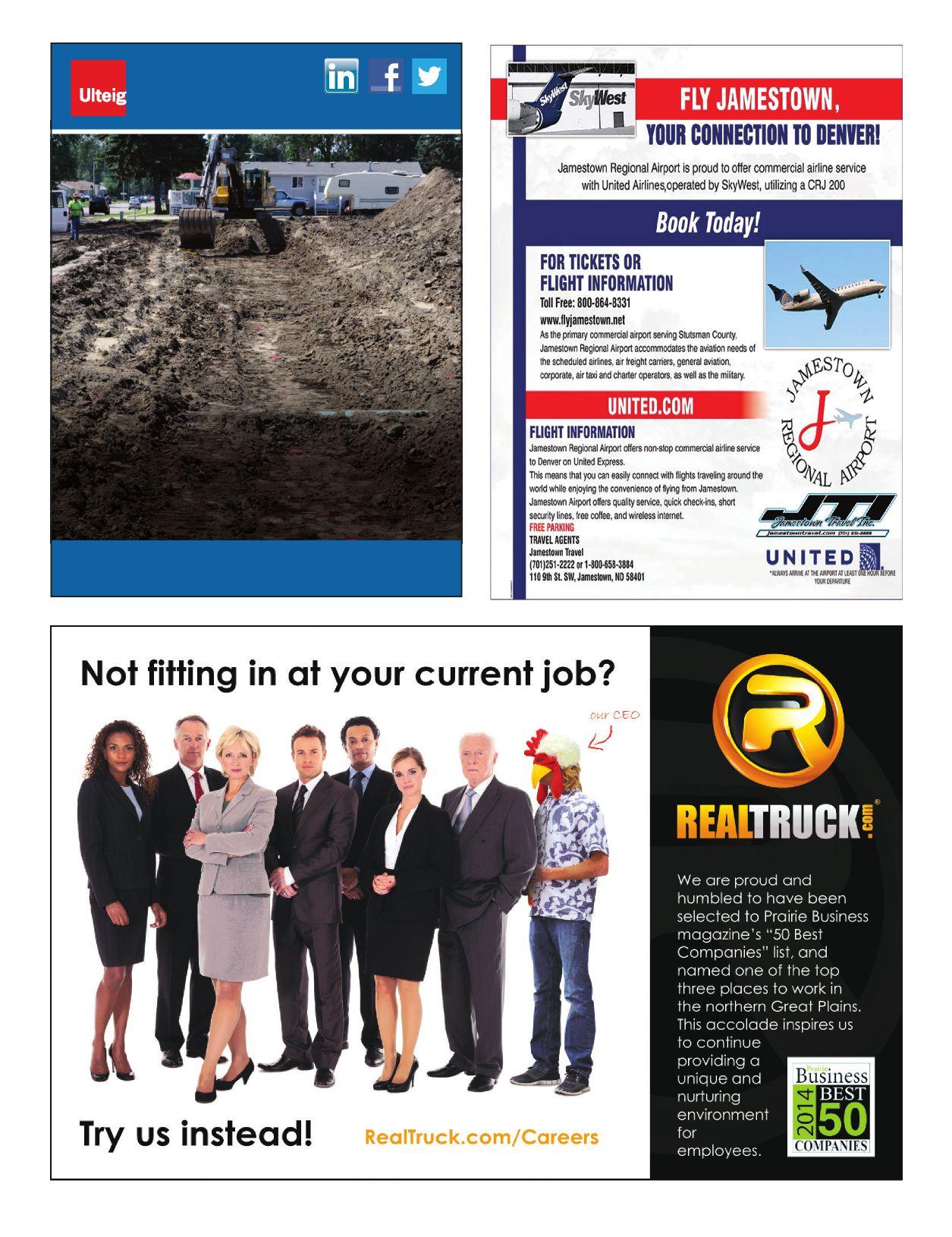
5 minute read
WORK LIFE
“Continue to help employees with work-life balance.”
“I would recommend more time off.”
“Keep up to speed with technology by deploying new software upgrades (in a timely way) and purchasing smaller, faster computers.”
“Flex time instead of 8 to 5.”
THE ANONYMOUS QUOTES REFLECT SOME OF THE DESIRES OF EMPLOYEES.
“More recognition for job per formance.”
“More front-line staff and less management.”
“More frequent communication of business goals and strategies.”
“We are like every other company. We need more labor. Good labor.”
“Fewer meetings. Faster hiring processes to bring new employees on board quicker.” ot h i n g i s m o re a p p e a l i n g t o m o s t workers than good pay and benefits, a cco rd i n g t o u n i o n l e a d e r s i n t h e nor thern Plains.
“Wages and benefits. That’s how you attract people,” says Tom Ricker, president and secretarytreasurer of the North Dakota AFL-CIO
“If you want to attract good, long-term employees, the first thing workers look at is wages Then they look at benefits,” says Ricker, whose organization represents about 18,000 workers across North Dakota.
His view, though not universally shared by employees in the northern Plains, is popular, especially among labor leaders.
But trying to determine what typical workers in North Dakota, South Dakota and western Minnesota really want is not a precise quest. The answer depends on who’s answering the question.
An Employee Engagement and Satisfaction Survey conducted by Prairie Business magazine attracted hundreds of anonymous comments, many of which did not mention pay or benefits
The need for a good work space and up-to-date equipment are among the non-pay factors cited in multiple messages from employees. Staff shortages that increase workloads are a common complaint
Some employees would like to be more involved in setting the direction of their company or at least be kept up to date on plans Others think their employer already holds too many unnecessary and unproductive meetings.
Some workers would appreciate recognition for good performance They would like greater flexibility to work outside of their offices And some are perfectly content with their jobs.
Ricker, who is based in Bismarck, says the oilproduction boom in western North Dakota is raising the bar for employee pay and benefits in the region. Oilfield workers can earn more than $100,000 a year, but the hours are long, and the work is difficult
Ricker used to work in Gwinner, N.D., at the Doosan manufacturing plant, which makes Bobcat equipment Doosan has approximately 1,200 hourly workers plus a few hundred salaried managers, making it one of the largest, private employers in the Fargo, N D , region Travis Swanson is the current vice president of United Steel Workers Local 560, which represents hourly workers at Doosan Swanson agrees that wages are very important to workers However, funding benefits such as vacation time and retirement plans might be of even greater, long-range consequence, he says.
Swanson ranks “all-encompassing benefits” as the most important issue for workers at the plant, followed by pay and working conditions.
After a probationary period of 60 days, workers at the growing Doosan plant start at about $21 an hour, which is relatively good for the area Pay and key benefits are negotiated for Doosan workers by union leaders and plant leaders. So employees are in a different situation than non-union workers in the region Most workers have to negotiate their own pay
Mark Anderson, president of the South Dakota Federation of Labor
AFL-CIO, represents approximately 8,000 workers. He points out federal statistics indicating that the productivity of American workers has increased 250 percent since 1948, but that compensation has increased only 113 percent.
“Our wages haven’t kept up with the productivity we ’ ve put out Workers want their fair share They’re entitled to it,” Anderson says “Ever ything you put on top of wages makes it more likely that person is going to stay on the job and do a good job ”
An employment and development official from Minnesota lends support to the general idea that pay and benefits are highly important to most workers
“We know from what employers tell us that the ones having trouble hiring are the ones not paying enough,” says Oriane Casale, assistant director of the Labor Market Information Office in the Minnesota Department of Employment and Economic Development “It’s obvious that wages and benefits are key to putting together a package for new employees, to attract them.”
Increasingly more workers seem to recognize the value of benefits, especially with all the recent political attention that has been focused on health care, she says However, there is a difference in perspective, depending on whether an employer is talking to high school students, college students or incumbent workers
The cur rent generation of college students prepar ing to enter the workforce is different, says Jeff Williamson, provost for Minnesota West Communit y & Technical College in western Minnesota
“They are ver y interested in salar y salar y with flexibilit y and the y want to be engaged w ith each other,” Williamson says Students also want to work in a healthy environment, he says
Minnesota West, which focuses on two-year programs, has campuses in Canby, Granite Falls, Jackson, Pipestone and Wor thington It also has education centers in Marshall, Luverne and Redwood Falls It serves about 2,100 students, mostly on its campuses.
Students are more flexible about where they go to work, in geographic terms, and to get ahead they don’t shy away from moving from company to company, Williamson says. They want credentials that will help them advance their careers.
Mary Medema, director of workforce development for the Sioux Falls, S D , Development Foundation, says a key factor to keep in mind is that a high percentage of people in the Dakotas region are employed and not looking for work.
“I think employers are giving them a lot of what they want,” she says “For a lot of occupations, there’s just not going to be a lot of job-seekers. They’re doing something else. They’re not just watching TV”
To increase the supply of available workers, states such as South Dakota will have to be more welcoming to newcomers, including immigrants, Medema says.
Businesses generally understand that they are going to have to become more involved in training and education prog rams to attract or retain good workers, and that’s good, she says
Employers also have to recognize that many workers want jobs that fit around their personal lives, she says.
“For some, it might just be a paycheck. For others, it’s way more than that They want to feel they have a broader purpose, ” Medema says
A report prepared in 2013 for the national Society for Human Resource Management organization evaluated the importance of employee opinion surveys as a business management tool. The report by David L. Van Rooy of Walmart Stores and Ken Oehler of Aon Hewitt concludes that companies that do not survey their employees are at a competitive disadvantage
But to be effective, companies have to use survey data to make positive changes in the workplace, not just collect information, according to the report
“Since the survey itself is becoming more of a tactical event every year, it is what happens with the data between survey administrations that will differentiate organizations the most,” the study says “Any organization that does not have broadreaching action planning following the survey will quickly lose ground in this area. ”
Laura Millett is the state council director for the South Dakota chapter of the Society for Human Resource Management She also works in human resources as the risk manager for the city of Aberdeen, S.D. Working conditions differ from the floor of a manufacturing plant, for example, to the office of a law firm, she says But workers’ core values might be generally similar
“From my vantage point, they want stability, and then pay and benefits, and to be engaged in their work,” she says “Everyone wants to feel like they’re part of their organization, that they’re valued ” PB
Rob Swenson Contributing writer RobSwensonMediaServices@gmail com
At Ulteig, building a relationship with you is as important as building the communities in which we all live and work. Our aim is to help you satisfy your project needs by being responsive, resolving issues, listening and exceeding your expectations.











